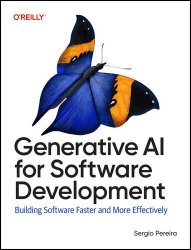 Название: Generative AI for Software Development: Building Software Faster and More Effectively (Final Release) Название: Generative AI for Software Development: Building Software Faster and More Effectively (Final Release)
Автор: Sergio Pereira
Издательство: O’Reilly Media, Inc.
Год: 2025
Страниц: 185
Язык: английский
Формат: epub
Размер: 16.2 MB
How does Generative AI impact software development? In this practical guide, author Sergio Pereira shows you how to use this new technology to write better code in a fraction of the time. You'll learn how to leverage Generative AI at each step of a software feature's lifecycle, from brainstorming implementation ideas to writing and testing code to releasing features in production. This book covers everything software developers need to know to get started with AI tools.
The author helps you filter through the hype, reviewing how 15+ AI tools perform in common daily coding tasks. You'll learn about key AI concepts, hands-on instructions for multiple AI tools, and considerations for their ethical use. This book guides you through real-world applications, explores popular tools and libraries, and shows you step-by-step how to adapt current methodologies and incorporate AI into your daily tasks.
With this guide, you'll explore:
The current landscape of generative AI tools for software development
How generative AI is being applied in code generation, bug detection, quality assurance, frontend development, and more
How to evaluate and choose the right AI tools for your needs
Best practices, predictions, and challenges
How you can prepare for future opportunities using generative AI Sergio Pereira has been a software engineer and CTO for 14 years and has built products for several fast-growing startups such as Bulk MRO, StudentFinance, and Candidly. For the last eight years he has built software products for the fintech industry under strict compliance requirements. As an early adopter of GitHub Copilot, he's a thought leader on the tool.
Who This Book Is For:
This book is for software engineers, product builders, CTOs, and curious tinkerers who want to stay ahead of the curve. Whether you’re building your next startup, leading an engineering team, or trying to automate tedious workflows, my goal is to help you think more clearly about what Generative AI can (and can’t) do in your day-to-day work. You’ll find practical strategies, critical evaluations, and enough context to make smart decisions, without needing to be a Machine Learning expert.
Chapter 1, “Code Generation and Autocompletion”, introduces the most widely adopted category of AI tools in software development: code generation and autocompletion assistants. It explains how tools like ChatGPT, GitHub Copilot, Cursor, and Gemini are reshaping the developer experience by reducing boilerplate, accelerating learning, and enhancing productivity. The chapter includes practical evaluations of over 30 tools, details their strengths and limitations, and compares browser-based assistants with IDE-integrated solutions. It also introduces a consistent evaluation methodology used throughout the book to rate code-generation tools based on real-world coding challenges.
Chapter 2, “User Interface and User Experience Design”, explores how generative AI is transforming UI/UX design and frontend development. It covers two main categories of tools: those that generate UI designs from natural language and those that convert those designs into working frontend code. By testing tools like Uizard and Bolt.new, the chapter reveals how AI is compressing design-to-code workflows from weeks to hours, enabling nondesigners to create interfaces, and supporting developers with ready-to-use HTML/CSS/React code. It also discusses the trade-offs of AI-generated designs, including quality, flexibility, and originality, and maps out where these tools add value versus where human creativity is still essential.
Chapter 3, “Bug Detection and Code Review” covers how AI-powered tools are transforming code reviews and bug detection, shifting them from slow, human-only processes to faster, more deterministic systems. It introduces a range of IDE-based, Git-integrated, and browser-based tools that automate code review with real-time feedback, security vulnerability detection, and style enforcement. Practical examples demonstrate how these tools catch issues like SQL injection, cross-site scripting (XSS) vulnerabilities, memory leaks, and inefficient loops, improving quality, velocity, and education for junior engineers.
Chapter 4, “Automated Testing and Quality Assurance”, explores how generative AI is streamlining software testing and QA. It compares tools that automate both functional and nonfunctional testing tasks, ranging from generating test cases from natural language prompts to detecting visual UI bugs and enabling self-healing tests. Through real-world examples and test scenarios, the chapter highlights how AI reduces the repetitive burden of QA, accelerates release cycles, and enables more reliable CI/CD processes, while still emphasizing the continued need for human testers in edge cases and judgment calls.
Contents:
Preface
1. Code Generation and Autocompletion
2. User Interface and User Experience Design
3. Bug Detection and Code Review
4. Automated Testing and Quality Assurance
5. Predictive Analytics and Performance Optimization
6. Documentation and Technical Writing
7. Chatbots and Virtual Assistants
8. Implementation Success Stories
Index
Скачать Generative AI for Software Development: Building Software Faster and More Effectively (Final Release)
|